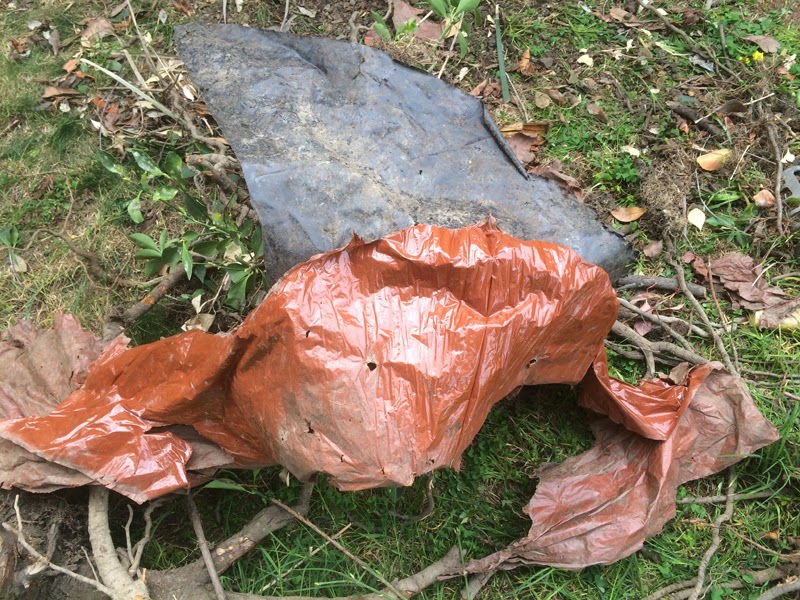If the calendar is to be believed, spring is officially upon us. And with spring comes our annual spring planting, wherein we sow seed in our two food gardens (our main food garden and our pottery garden), replace any succulents that may have succumbed to the winter weather, add to our growing cactus garden, and possibly add to our growing orchard. So far this spring we have done all of the aforementioned except for adding to the number of cactus on-hand. In addition to all of this, we replaced some unsightly bushes in front of our New House.
Spring Planting 1
Let us first visit our food garden. When we last visited our food garden it was overgrown with accursed clovers, and Becky was using our semi-homemade sifter box to clean out all of the unsightly and unwanted weeds. After much manual labour (95% Becky, 5% Bish) we managed to clean up the food garden, after which we mixed in a fresh batch of organic garden soil - the result of which you can see below.
With the food garden freshly tilled and prepped it was time to sew some new seed.
Here is our freshly planted food garden. This year we have the usual strawberries, a couple of cucumbers, onions, various melons, various lettuces, spinach, and corn. Not yet planted are the potatoes. The shiny plastic spinner things are intended to discourage birds and squirrels from helping themselves to the goodness from our food garden.
Spring Planting 2
One of our voodoo (A. Undulatum x Arboreum 'Zwartkop') plants died. It was a slow deterioration that seemed to start at the top and work its way downward.
Look at that sad, dried up stump sticking up from the ground.
We replaced it with this beautiful Senecio Mandraliscae Blue, also known as a Blue Finger Plant. As with several other of our succulents, this plant is native to South Africa.
Spring Planting 3
In the previous Episode you saw the pottery garden cleaned up and ready for planting.
Here you see the pottery garden planted. The sprouted plants are various peppers, mostly bells, and the fishy pots contain thyme and sweet basil and lime basil seeds.
BYA Interlude
Now it is time for a Back Yard Archaeology interlude. While digging up the roots from some unsightly bushes in front of our New House (more on that later) we discovered more pre-Bishopian artifacts.
First up for your consideration is this plastic sheeting that was buried a couple of inches below the surface. In addition to the black plastic we've found previously, we uncovered some reddish plastic. So far we have been unable to determine which plastic is more ancient, as they were both found together at the same depth and location.
Next up is this unusual wheel. It appears to have some sort of hieroglyph on one side, but it is very degraded. If you recognize the hieroglyph, and know its society of origin, please leave a comment.
The other side of the wheel is blank.
Standing on edge you can see that this wheel is clearly too small to be used on any kind of ancient cart or wagon. So what was this wheel used for? Was it some sort of ancient talisman? Did the pre-Bishopians truly understand the many uses for the wheel? Did they have ball bearing technology?
Spring Planting 4
Before we could plant a new tree in our orchard we had to clear out some old trees. And by old trees I mean two do-nothing trees that were here when we bought our New House, and which I've been thinking about removing for some time now. We also had to remove an old, dead, decomposing tree stump (see the previous Episode).
These were the offending trees.
The corner is much better without those do-nothing trees.
The tree we chose to add to our small orchard is an ultra dwarf goldmine nectarine tree, which means, as I understand it, that it is a goldmine nectarine tree that won't get real tall.
Look at that beautiful nectarine tree.
Here you can see it in its larger context.
Spring Planting 5
We are fans of bushes and plants surrounding our New House, but the particular bushes in front of our New House were quite unsightly, and they were obscuring the view out of my office window.
Trimming these bushes down to below window-level would only have made them more unsigtly, so we decided to remove them and plant new, shorter bushes in their place.
This is the view with the bushes cut down a bit. The pre-Bishopian plastic, mentioned above, came from this area.
The shallow roots of the unsightly bushes. They came out pretty easily. The dead root on the left was from a dead bush that we had previously removed.
We replaced the unsightly bushes with four Faulkner Boxwood (Buxus microphylla 'Faulkner') bushes. There were several varieties of Boxwood from which to choose, and we chose these in part because the don't get really tall.
Look at that good looking house!
Thus concludes our first session of spring
bIsh


















